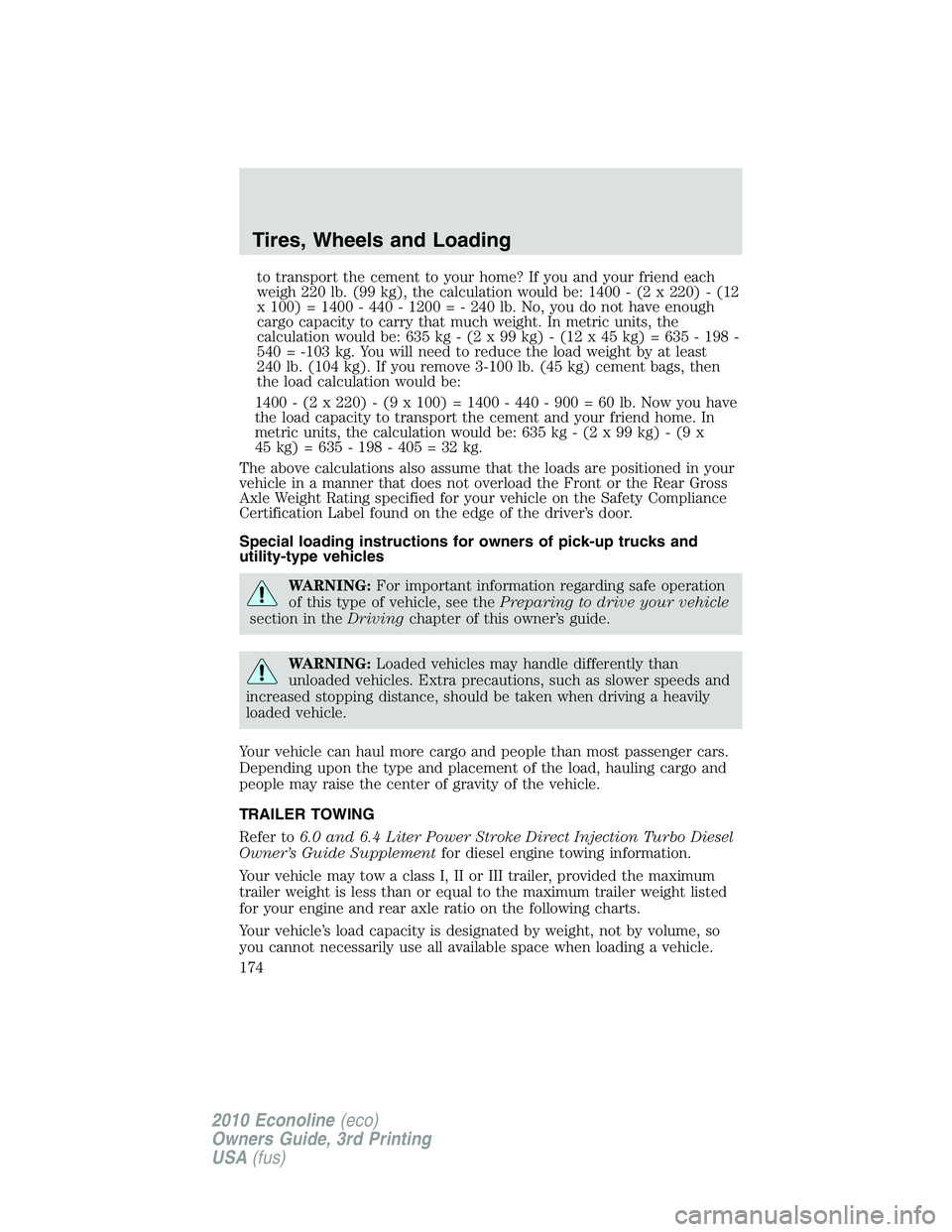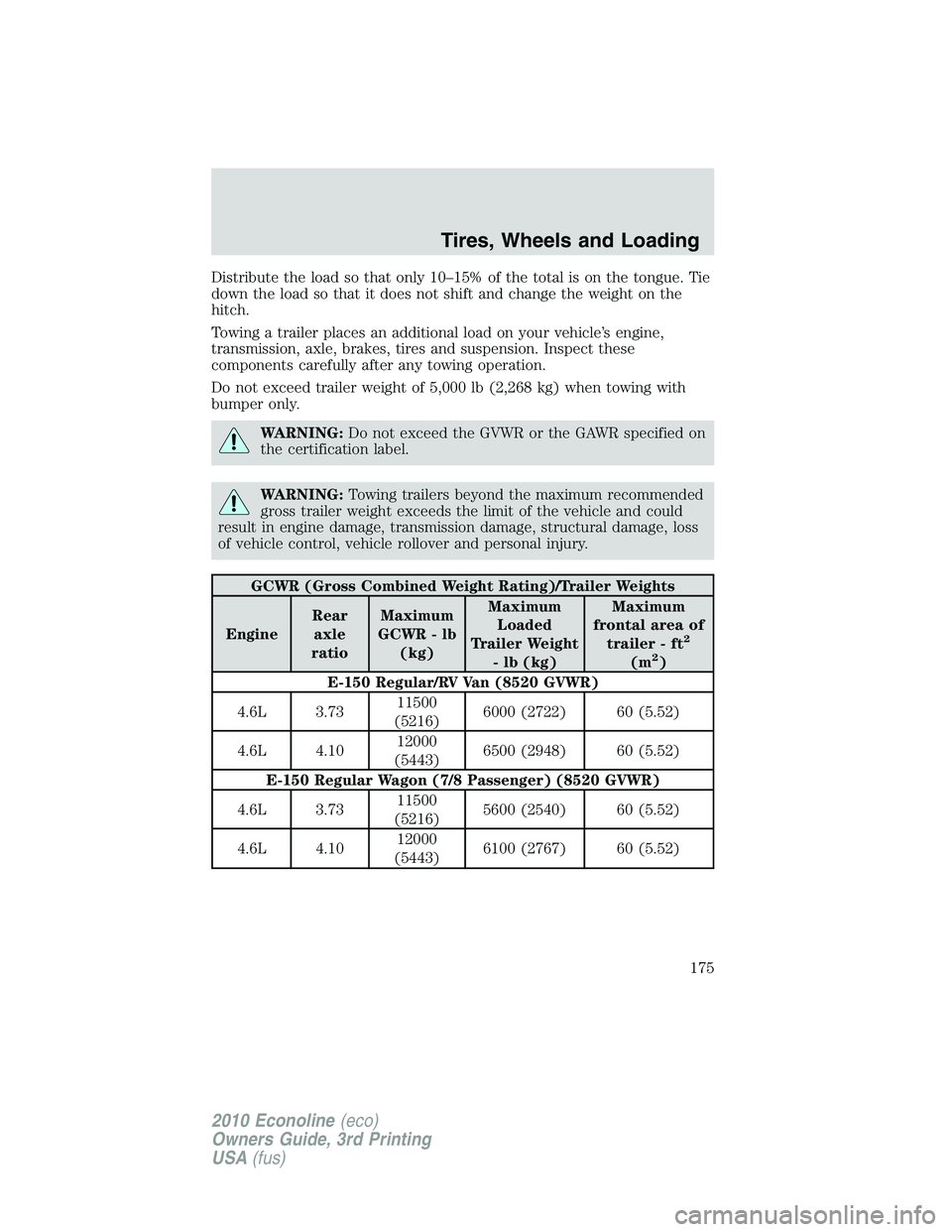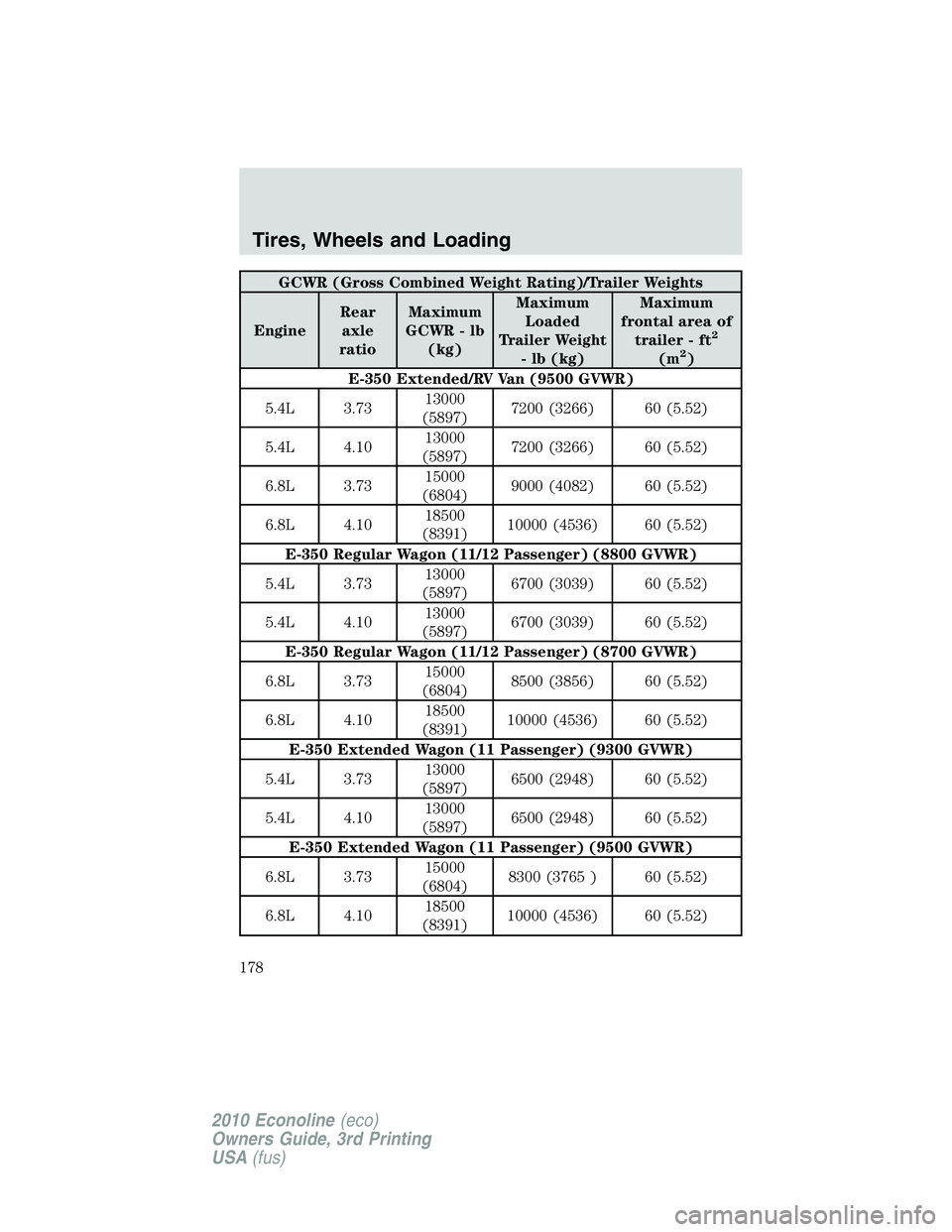Page 161 of 327

Performing the TPMS reset procedure (Vehicles that have wheels
with snap-in pressure sensors)
It is recommended that you read the entire procedure before attempting.
1. Drive the vehicle above 20 mph (32 km/h) for at least two minutes
and then park in a safe location where you can easily get to all four tires
and have access to an air pump.
2. Place the ignition in the off position and keep the key in the ignition.
3. Cycle the ignition to the on
position with the engine off.
4. Turn the hazard flashers on then
off three times. This must be
accomplished within 10 seconds.
If the reset mode has been entered successfully, the horn will sound
once, the TPMS indicator
will flash and the message center (if
equipped) will displayTRAIN LEFT FRONT TIRE. If this does not
occur, please try again starting at Step 2.
If after repeated attempts to enter the reset mode, the horn does not
sound, the TPMS indicator
does not flash and the message center (if
equipped) does not displayTRAIN LEFT FRONT TIRE, seek service
from your authorized dealer.
Tires, Wheels and Loading
161
2010 Econoline(eco)
Owners Guide, 3rd Printing
USA(fus)
Page 164 of 327
3. Cycle the ignition from off to on
three (3) times ending in the on
position—DO NOTstart the engine.
4. Press and hold the brake pedal
for two (2) seconds, then release.
5. Turn the ignition to off—DO
NOTremove the key.
6. Cycle the ignition from off to on three (3) times ending in on.DO
NOTstart the engine.
If the reset mode has been entered successfully, the horn will sound
once, the TPMS indicator
will flash and the message center will
displayTRAIN LEFT FRONT TIRE.
If after repeated attempts to enter the reset mode, the horn does not
sound, the TPMS indicator
does not flash and the message center
does not displayTRAIN LEFT FRONT TIRE, contact your authorized
dealer as soon as possible.
Tires, Wheels and Loading
164
2010 Econoline(eco)
Owners Guide, 3rd Printing
USA(fus)
Page 171 of 327
•Example only:
WARNING:Exceeding the Safety Compliance Certification Label
vehicle weight rating limits could result in substandard vehicle
handling or performance, engine, transmission and/or structural
damage, serious damage to the vehicle, loss of control and personal
injury.
Tires, Wheels and Loading
171
2010 Econoline(eco)
Owners Guide, 3rd Printing
USA(fus)
Page 174 of 327

to transport the cement to your home? If you and your friend each
weigh 220 lb. (99 kg), the calculation would be: 1400 - (2 x 220) - (12
x 100) = 1400 - 440 - 1200 = - 240 lb. No, you do not have enough
cargo capacity to carry that much weight. In metric units, the
calculation would be: 635 kg - (2 x 99 kg) - (12 x 45 kg) = 635 - 198 -
540 = -103 kg. You will need to reduce the load weight by at least
240 lb. (104 kg). If you remove 3-100 lb. (45 kg) cement bags, then
the load calculation would be:
1400 - (2 x 220) - (9 x 100) = 1400 - 440 - 900 = 60 lb. Now you have
the load capacity to transport the cement and your friend home. In
metric units, the calculation would be: 635 kg - (2 x 99 kg) - (9 x
45 kg) = 635 - 198 - 405 = 32 kg.
The above calculations also assume that the loads are positioned in your
vehicle in a manner that does not overload the Front or the Rear Gross
Axle Weight Rating specified for your vehicle on the Safety Compliance
Certification Label found on the edge of the driver’s door.
Special loading instructions for owners of pick-up trucks and
utility-type vehicles
WARNING:For important information regarding safe operation
of this type of vehicle, see thePreparing to drive your vehicle
section in theDrivingchapter of this owner’s guide.
WARNING:Loaded vehicles may handle differently than
unloaded vehicles. Extra precautions, such as slower speeds and
increased stopping distance, should be taken when driving a heavily
loaded vehicle.
Your vehicle can haul more cargo and people than most passenger cars.
Depending upon the type and placement of the load, hauling cargo and
people may raise the center of gravity of the vehicle.
TRAILER TOWING
Refer to6.0 and 6.4 Liter Power Stroke Direct Injection Turbo Diesel
Owner’s Guide Supplementfor diesel engine towing information.
Your vehicle may tow a class I, II or III trailer, provided the maximum
trailer weight is less than or equal to the maximum trailer weight listed
for your engine and rear axle ratio on the following charts.
Your vehicle’s load capacity is designated by weight, not by volume, so
you cannot necessarily use all available space when loading a vehicle.
Tires, Wheels and Loading
174
2010 Econoline(eco)
Owners Guide, 3rd Printing
USA(fus)
Page 175 of 327

Distribute the load so that only 10–15% of the total is on the tongue. Tie
down the load so that it does not shift and change the weight on the
hitch.
Towing a trailer places an additional load on your vehicle’s engine,
transmission, axle, brakes, tires and suspension. Inspect these
components carefully after any towing operation.
Do not exceed trailer weight of 5,000 lb (2,268 kg) when towing with
bumper only.
WARNING:Do not exceed the GVWR or the GAWR specified on
the certification label.
WARNING:Towing trailers beyond the maximum recommended
gross trailer weight exceeds the limit of the vehicle and could
result in engine damage, transmission damage, structural damage, loss
of vehicle control, vehicle rollover and personal injury.
GCWR (Gross Combined Weight Rating)/Trailer Weights
EngineRear
axle
ratioMaximum
GCWR - lb
(kg)Maximum
Loaded
Trailer Weight
- lb (kg)Maximum
frontal area of
trailer - ft
2
(m2)
E-150 Regular/RV Van (8520 GVWR)
4.6L 3.7311500
(5216)6000 (2722) 60 (5.52)
4.6L 4.1012000
(5443)6500 (2948) 60 (5.52)
E-150 Regular Wagon (7/8 Passenger) (8520 GVWR)
4.6L 3.7311500
(5216)5600 (2540) 60 (5.52)
4.6L 4.1012000
(5443)6100 (2767) 60 (5.52)
Tires, Wheels and Loading
175
2010 Econoline(eco)
Owners Guide, 3rd Printing
USA(fus)
Page 176 of 327
GCWR (Gross Combined Weight Rating)/Trailer Weights
EngineRear
axle
ratioMaximum
GCWR - lb
(kg)Maximum
Loaded
Trailer Weight
- lb (kg)Maximum
frontal area of
trailer - ft
2
(m2)
E-150 Regular/RV Van (8600 GVWR)
5.4L 3.7313000
(5897)7400 (3357) 60 (5.52)
5.4L 4.1013000
(5897)7400 (3357) 60 (5.52)
E-150 Extended Van (8600 GVWR)
4.6L 3.7311500
(5216)5900 (2676) 60 (5.52)
4.6L 4.1012000
(5443)6400 (2903) 60 (5.52)
E-150 Extended Van (8600 GVWR)
5.4L 3.7313000
(5897)7300 (3311) 60 (5.52)
5.4L 4.1013000
(5897)7300 (3311) 60 (5.52)
E-150 Regular Wagon (7/8 Passenger) (8600 GVWR)
5.4L 3.7313000
(5897)7000 (3175) 60 (5.52)
5.4L 4.1013000
(5897)7000 (3175) 60 (5.52)
E-250 Regular/RV Van (8900 GVWR)
4.6L 3.7311500
(5216)6000 (2722) 60 (5.52)
4.6L 4.1012000
(5443)6500 (2948) 60 (5.52)
Tires, Wheels and Loading
176
2010 Econoline(eco)
Owners Guide, 3rd Printing
USA(fus)
Page 177 of 327
GCWR (Gross Combined Weight Rating)/Trailer Weights
EngineRear
axle
ratioMaximum
GCWR - lb
(kg)Maximum
Loaded
Trailer Weight
- lb (kg)Maximum
frontal area of
trailer - ft
2
(m2)
E-250 Extended/RV Van (8900 GVWR)
4.6L 3.7311500
(5216)5900 (2676) 60 (5.52)
4.6L 4.1012000
(5443)6400 (2903) 60 (5.52)
E-250 Regular/RV Van (9000 GVWR)
5.4L 3.7313000
(5896)7400 (3357) 60 (5.52)
5.4L 4.1013000
(5896)7400 (3357) 60 (5.52)
E-250 Cutaway (138” wheelbase, single rear wheel) (8600
GVWR)
4.6L 4.1012000
(5443)7500 (3402) 60 (5.52)
E-250 Extended/RV Van (9000 GVWR)
5.4L 3.7313000
(5896)7300 (3311) 60 (5.52)
5.4L 4.1013000
(5896)7300 (3311) 60 (5.52)
E-350 Regular/RV Van (9500 GVWR)
5.4L 3.7313000
(5897)7300 (3311) 60 (5.52)
5.4L 4.1013000
(5897)7300 (3311) 60 (5.52)
6.8L 3.7315000
(6804)9100 (4128) 60 (5.52)
6.8L 4.1018500
(8391)10000 (4536) 60 (5.52)
Tires, Wheels and Loading
177
2010 Econoline(eco)
Owners Guide, 3rd Printing
USA(fus)
Page 178 of 327

GCWR (Gross Combined Weight Rating)/Trailer Weights
EngineRear
axle
ratioMaximum
GCWR - lb
(kg)Maximum
Loaded
Trailer Weight
- lb (kg)Maximum
frontal area of
trailer - ft
2
(m2)
E-350 Extended/RV Van (9500 GVWR)
5.4L 3.7313000
(5897)7200 (3266) 60 (5.52)
5.4L 4.1013000
(5897)7200 (3266) 60 (5.52)
6.8L 3.7315000
(6804)9000 (4082) 60 (5.52)
6.8L 4.1018500
(8391)10000 (4536) 60 (5.52)
E-350 Regular Wagon (11/12 Passenger) (8800 GVWR)
5.4L 3.7313000
(5897)6700 (3039) 60 (5.52)
5.4L 4.1013000
(5897)6700 (3039) 60 (5.52)
E-350 Regular Wagon (11/12 Passenger) (8700 GVWR)
6.8L 3.7315000
(6804)8500 (3856) 60 (5.52)
6.8L 4.1018500
(8391)10000 (4536) 60 (5.52)
E-350 Extended Wagon (11 Passenger) (9300 GVWR)
5.4L 3.7313000
(5897)6500 (2948) 60 (5.52)
5.4L 4.1013000
(5897)6500 (2948) 60 (5.52)
E-350 Extended Wagon (11 Passenger) (9500 GVWR)
6.8L 3.7315000
(6804)8300 (3765 ) 60 (5.52)
6.8L 4.1018500
(8391)10000 (4536) 60 (5.52)
Tires, Wheels and Loading
178
2010 Econoline(eco)
Owners Guide, 3rd Printing
USA(fus)